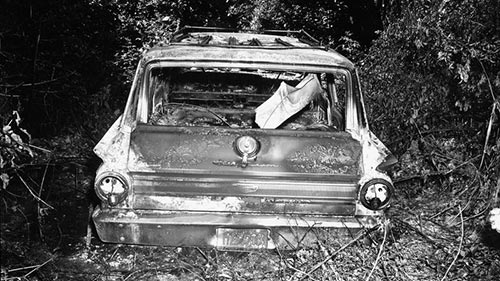Neshoba County, MS: 1964
Mississippi burns as Klan members target churches involved in the civil rights movement.
Condado de Neshoba, MS: 1964
Mississippi arde mientras los miembros del Klan atacan iglesias involucradas en el movimiento por los derechos civiles.



From June of 1964 to January of 1965, KKK nightriders burned 31 Black churches across Mississippi, including Mount Zion AME where three civil rights workers, James Chaney, Andrew Goodman, and Michael Schwerner, spent time registering Black Mississippians to vote. After leaving a meeting at the church, the men were arrested and went missing.
Their bodies were discovered after a 44-day search that garnered widespread national attention. While the men were missing, Mississippi officials downplayed the significance of the case, calling it a hoax devised to garner sympathy for the civil rights movement.
This historical moment would eventually inspire the feature film Mississippi Burning (1988). Although more than 150 FBI agents ultimately descended on Neshoba County to investigate the disappearance, only one person, former Klan leader Edgar Ray Killen, was convicted.
Image Descriptions
- Freedom Summer activists sing before leaving training sessions at Western College for Women in Oxford, Ohio, for Mississippi in June 1964.
- In this picture released by the FBI and the State of Mississippi Attorney General's Office, the burnt-out station wagon that slain civil rights workers James Chaney, Andrew Goodman, and Michael Schwerner were driving in is seen in the Bogue Chitto swamp, some 13 miles northeast of Philadelphia, Mississippi.
- An FBI flyer for the missing civil rights students Andrew Goodman, James Chaney, and Michael Schwerner.



Entre junio de 1964 y enero de 1965, los “jinetes de la noche” del Ku Klux Klan incendiaron 31 iglesias negras en todo Mississippi, incluida la Iglesia AME Mount Zion, donde tres trabajadores de los derechos civiles —James Chaney, Andrew Goodman y Michael Schwerner— habían estado registrando en el censo electoral a los habitantes negros de Mississippi. Tras salir de una reunión en la iglesia, los hombres fueron capturados y desaparecidos.
Sus cuerpos sin vida se descubrieron tras una búsqueda de 44 días que contó con una amplia cobertura a nivel nacional. Mientras los hombres estaban desaparecidos, los oficiales de Mississippi minimizaron la importancia del caso, tachándolo de fraude organizado para aumentar la simpatía hacia el movimiento por los derechos civiles.
Este momento histórico terminaría por inspirar el largometraje Mississippi en llamas (Mississippi Burning) (1988). Aunque más de 150 agentes del FBI se desplazaron hasta el Condado de Neshoba para investigar la desaparición, solo una persona, el antiguo líder del Klan Edgar Ray Killen, fue condenada.
Descripciones
- Activistas del “Verano de la Libertad” cantan antes de salir de sus sesiones de capacitación en la Western College for Women en Oxford, Ohio, hacia Mississippi en junio de 1964.
- En esta fotografía, publicada por el FBI y la Oficina del Procurador General del Estado de Mississippi, puede verse la camioneta quemada que conducían los activistas por los derechos civiles James Chaney, Andrew Goodman y Michael Schwerner en el pantano de Bogue Chitto, a unas 13 millas (20 km) al noroeste de Filadelfia, Mississippi.
- Un volante del FBI que anuncia la búsqueda de los estudiantes desaparecidos Andrew Goodman, James Chaney y Michael Schwerner, activistas por los derechos civiles.



